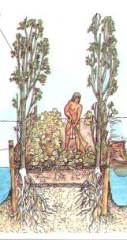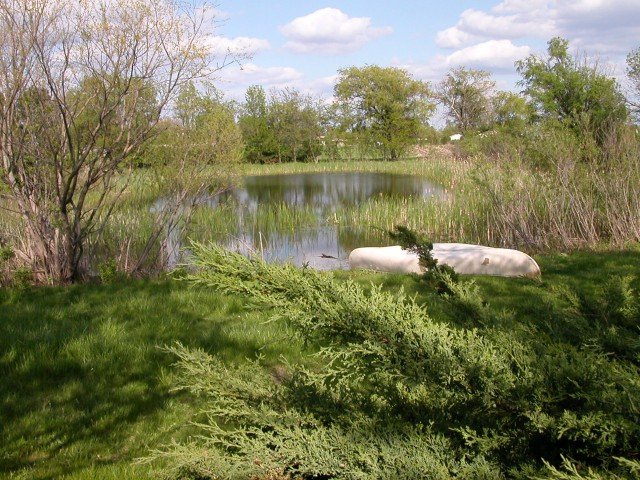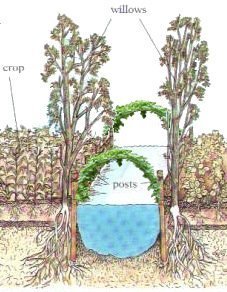Discover the Wild Leek (Ramps)
Learn how the influence of ramps has built relationships within
Learn how the influence of ramps has built relationships within
What is a composting toilet? A composting toilet is a
Here is the latest presentation and virtual tour of how
Spring is here at Midwest Permaculture. It’s time for the
Why Chinampas Gardens are part of This Permaculture DesignChinampas Gardens are artificial islands or peninsulas created by scooping nutrient-rich lake, swamp or pond muck into a woven cage so that crops can be grown above the waterline in a wet environment. Within this simple design, several unique functions are accomplished at once: a micro-climate that prevents early frost damage; an extremely productive soil that is mostly self-sustaining; a self-watering system created by water wicking in from the sides as moisture evaporates from the surface of the beds; and the growing of plants and fish within the same area. In Particular we want to:
|
 |
Chinampas Gardens ExplainedThere is plenty of room across the south shore of our pond and we plan to build three to five Chinampas extending out into the water like peninsulas for about 25 feet. They are located close to Earthcamp Village so that students, interns and/or guests camping in the cabins can quickly and easily access the chinampas gardens for food, fishing and enjoyment.
About the Stelle Pond When our community of Stelle was built, a small pond just outside of town was dug so that residents might have some sort of wetland close by. Over the years we have watched it mature and recent testing has revealed that the water is amazingly clean and free of agricultural chemicals. The watershed that feeds this pond is all on the Stelle community property. But as with most ponds, with time there has been some silt buildup close to shore which creates an ideal environment for cattail and other shore loving plants.

History of Chinampas
How and Why they were so Productive As in good permaculture design, Chinampas work by turning wastes into resources while stacking functions to maximize yields and minimizing work. After a plot is staked out into low ground or shallow ponds and lakes, a fence was woven between the stakes to create a cage or large basket that the farmers could then fill with the surrounding sediment and various forms of vegetation. The beds would be built high enough to become permanently above the high water mark and willows would be planted on the edges to protect the banks from erosion over the long term for when the posts rotted. Channels were maintained between the Chinampas for canoe access and for the growing of fish and water fowl.
Since water is always available to the bed, as water evaporates from the surface it is replaced by capillary action from below. A chinampas never has to be watered once a plants root systems are down. The grower never has to worry about drought or watering again. And because the ground is permanently moist by the capillary action of water being pulled upwards by ground evaporation, soluble nutrients stay suspended and available to the plant roots. What is created is a perfect root zone environment…all the time!
The Edge Effect In a good permaculture design we take advantage of the areas where one system comes into contact with another (the edge zone) as this tends to be an area of greater activity and productivity. For example, where the water meets the banks there will be plenty of plants that could grow right along the bank or just into the water that would provide a unique species for food (humans, fish, ducks) or simply biomass for increased garden fertility. Insects attracted to the edge plants become food for fish. Ducks eat the plants at the shore. Their droppings becomes food for the fish. All remaining residue and the fish poo sinks to the bottom to become fertile detritus that can be scooped up annual and added to the garden beds. And because the fish are raised in channels they are easy to harvest with nets. Because ducks and geese are part of the system they are trained to help with keeping the banks weeded as well as working in the garden beds. They are great slug and weed eaters. Trellis over the Channels In some areas, arching trellises were extended over the narrow channels and vining plants such as squash, cucumber and beans were planted so that their yielding crop could be harvested directly into a canoe, paddled to shore for unloading, and then return for more. An Amazing Microclimate Combining the beneficial effects of surrounding water and trees to a growing environment is also a brilliant strategy. The water in the channels maintains a more constant temperature than soil, so the entire chinampas area establishes a micro-climate that greatly ameliorates the effects of frost damage — a simple method of season extension that does not require expensive row covers or greenhouses. Trees not only held the banks in place and provided shade and some fruit for growers, they also protected the chinampas gardens from high winds on gusty days while holding in warmer air underneath the canopy on cold days. Together, these created a higher temperature and humidity level than the surrounding farmland which greatly mitigated frost damage.
“Creating channels of warmer air, the morphology of raised fields and associated canals can raise air temperatures as much as Maintaining the Soil Caring for the fertility of the soil in this design is almost self-sustaining. Simply scraping up the detritus on the bottom of the waterway and adding it to the soil is all that needs to be done. Detritus is the organic matter (leaves from garden plants, weeds, duck and fish poo) that falls to the bottom of a pond and breaks down. One could make the analogy that it is simply another way of composting waste materials into soil. Benefits of Chinampas Gardening
A more perfect example of stacking functions in a permaculture system can rarely be found. Fish, fowl, and water plants could be harvested from the water channel and vegetables, fruit, and lattice-grown vines from the bed itself.
So….how can you apply chinampas design into your own system at your home? Let us know how it goes and share your stories on the Midwest Permaculture networking site.
This Article Co-Written by Bri Wrench and Bill Wilson |

Bri Wrench earned her Permaculture Design Course Certificate from Midwest Permaculture in the fall of 2012 and currently homesteads on a small, rented farm in central Ohio. She and her husband Kenny are looking to buy property to start a permaculture demonstration farm. |

Bill Wilson is a permaculture teacher, designer, and the co-founder of Midwest Permaculture. |
[contentblock id=10]